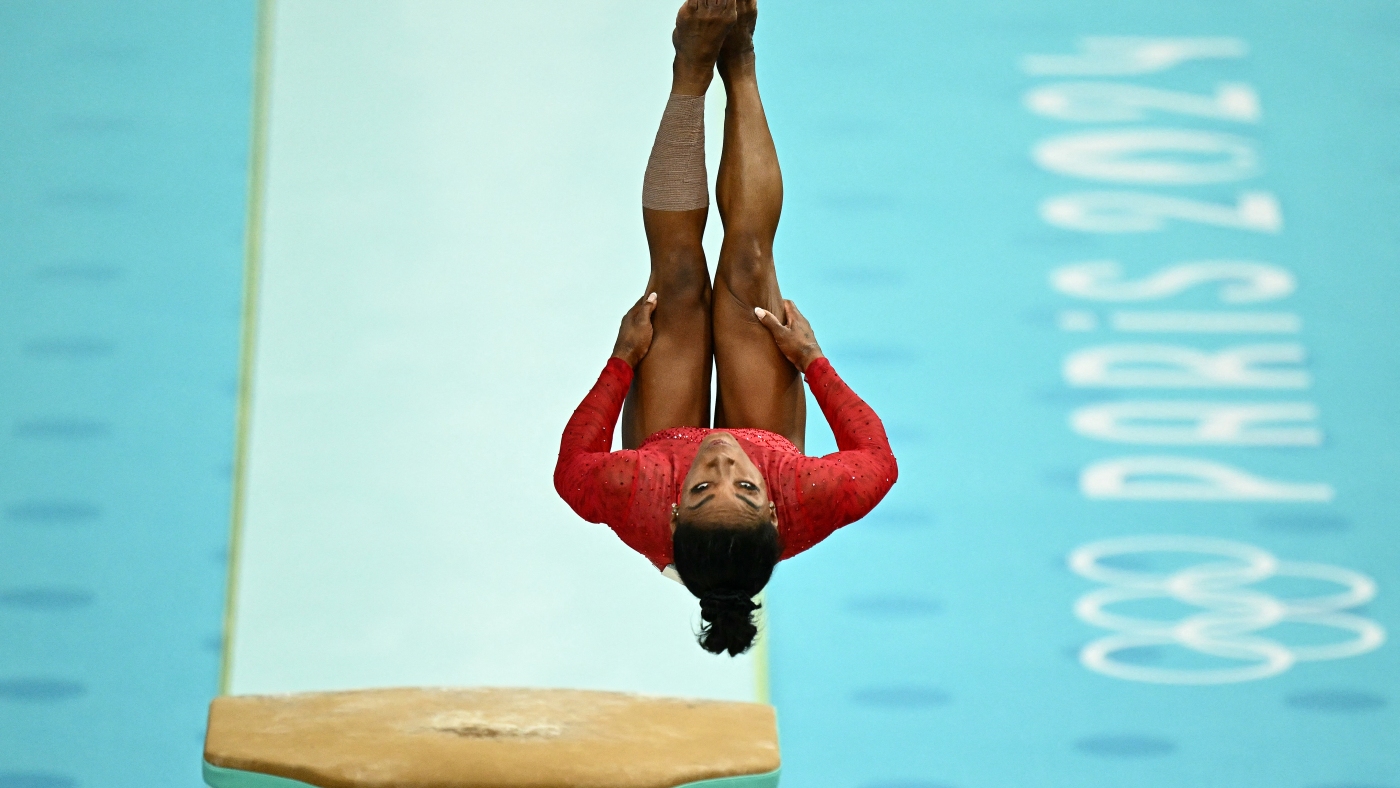Fitness
What Happens to Your Body When You Do Squats, Push-Ups and Crunches Every Day for 30 Days? | BOXROX

Exercise is a fundamental aspect of maintaining a healthy lifestyle. Among various exercises, squats, push-ups, and crunches are classic moves that engage multiple muscle groups and can be performed without any equipment. These exercises have stood the test of time for their effectiveness and simplicity. But what happens if you commit to doing these exercises every day for 30 days?
That is what you are about to find out in the paragraphs below. We talked about how to do the exercises, how to mitigate possible problems, three different scenarios of how your body could change depending on your body fat percentage and training history, and also overall changes to your physical and mental well-being.
Let’s get it on, shall we?
Benefits of Daily Squats, Push-Ups, and Crunches
Enhanced Muscle Strength and Endurance
One of the most immediate and noticeable benefits of performing squats, push-ups, and crunches daily is the increase in muscle strength and endurance.
Squats
Squats primarily target the quadriceps, hamstrings, glutes, and lower back muscles. As you repeatedly perform squats, these muscles adapt by becoming stronger and more resilient. A study published in the Journal of Strength and Conditioning Research found that individuals who performed lower-body resistance exercises like squats experienced significant increases in muscle strength and endurance over time.
Push-Ups
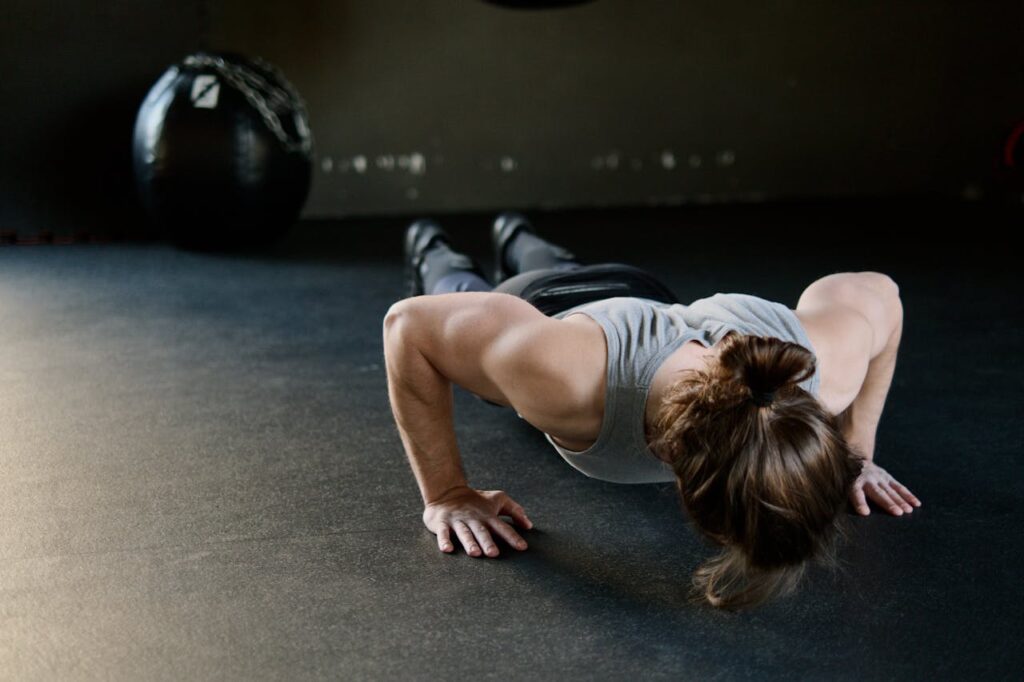
Push-ups are a compound exercise that engages the pectoral muscles, triceps, deltoids, and core. Regularly performing push-ups enhances upper body strength and improves muscular endurance. Research indicates that push-up performance is a reliable indicator of upper body strength and endurance.
Crunches
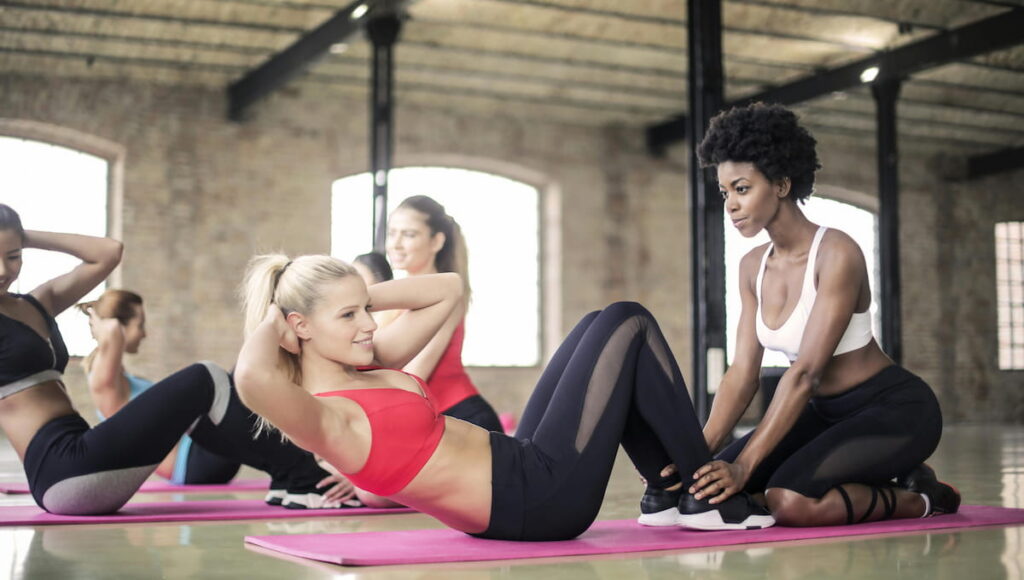
Crunches focus on the abdominal muscles, particularly the rectus abdominis. Daily crunches can lead to stronger and more defined abs. A study in the Journal of Sports Science & Medicine found that regular abdominal exercises contribute to improved core strength and stability.
Improved Cardiovascular Health
While squats, push-ups, and crunches are primarily strength-building exercises, they also offer cardiovascular benefits. Engaging in these exercises increases heart rate and promotes better circulation. The cumulative effect of performing these exercises daily can lead to improved cardiovascular health. The American Heart Association notes that regular physical activity strengthens the heart muscle, improves blood flow, and reduces the risk of cardiovascular diseases.
Enhanced Metabolic Rate and Fat Loss
Regular exercise, including bodyweight exercises like squats, push-ups, and crunches, boosts metabolic rate. This increase in metabolism helps burn calories more efficiently, aiding in weight loss and fat reduction. A study published in the International Journal of Obesity found that resistance training exercises significantly enhance resting metabolic rate and promote fat loss.
Better Posture and Flexibility
Performing squats, push-ups, and crunches daily can also improve posture and flexibility.
Squats
Squats enhance the strength of the muscles that support the spine, which can lead to better posture. Additionally, they improve the flexibility of the hips, knees, and ankles.
Push-Ups
Push-ups help in strengthening the muscles of the upper back, shoulders, and core, all of which are essential for maintaining good posture.
Crunches
Strong abdominal muscles contribute to better posture by supporting the spine and reducing the risk of lower back pain.
Mental Health Benefits
Regular exercise has well-documented benefits for mental health. Engaging in daily physical activity can reduce stress, anxiety, and symptoms of depression. A study in the Journal of Psychiatric Research found that consistent exercise positively affects mood and cognitive function.
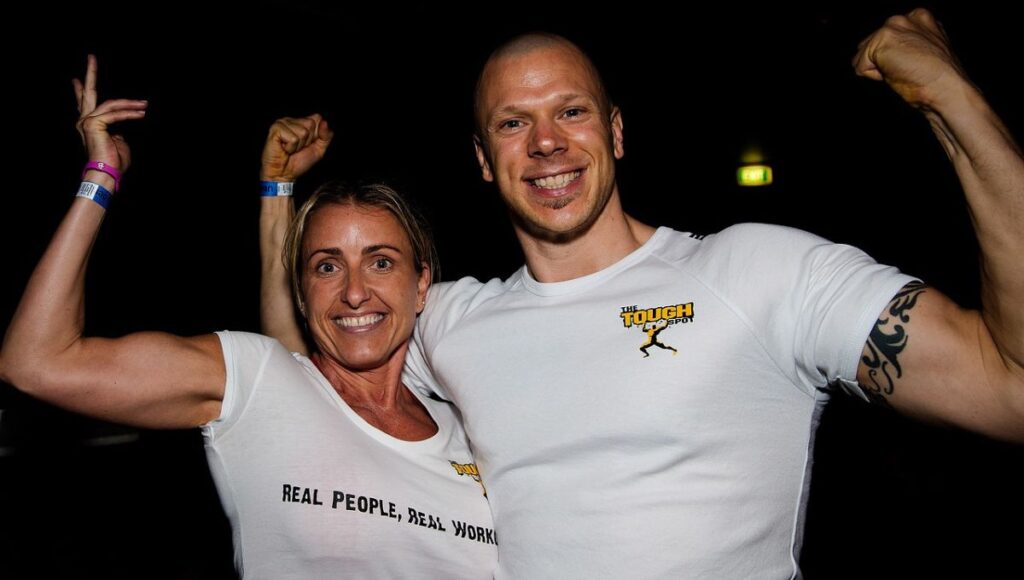
Potential Risks and How to Mitigate Them
While there are numerous benefits to daily exercise, there are also potential risks, especially when exercises are performed incorrectly or without adequate rest.
Overuse Injuries
Performing the same exercises every day without variation can lead to overuse injuries. Overuse injuries occur when the same muscle groups are repeatedly stressed without sufficient recovery time. This can result in muscle strains, joint pain, and tendonitis.
Mitigation Strategies
- Proper Form: Ensuring that you perform each exercise with correct form is crucial. Poor form can lead to unnecessary strain and injury.
- Variation: Incorporating variations of each exercise can prevent overuse injuries. For example, mixing standard squats with sumo squats or adding inclined push-ups can alter the muscle engagement and reduce repetitive strain.
- Rest: Even though the challenge is to perform these exercises daily, incorporating active rest days where you perform lighter versions or fewer repetitions can help with recovery.
Muscle Imbalance
Focusing solely on squats, push-ups, and crunches can lead to muscle imbalances. For instance, while push-ups strengthen the chest and triceps, they might neglect the back muscles if not complemented with pulling exercises.
Mitigation Strategies
- Balanced Routine: Include exercises that target opposing muscle groups. For example, adding rows or pull-ups can balance the muscle engagement.
- Full-Body Workouts: Incorporate full-body workouts that ensure all major muscle groups are exercised.
Plateau Effect
The body can adapt to the same routine over time, leading to a plateau where progress slows down or stops.
Mitigation Strategies
- Progressive Overload: Gradually increasing the intensity, volume, or resistance of the exercises can help overcome plateaus. For example, adding weights or increasing the number of repetitions can challenge the muscles further.
- Mixing Intensity: Alternating between high-intensity and low-intensity days can keep the body guessing and prevent adaptation.
What To Do If Bodyweight Exercises Become Too Easy For You?

Detailed Analysis of Each Exercise
Squats
Technique
- Starting Position: Stand with feet shoulder-width apart, toes slightly turned out.
- Movement: Lower your body by bending your knees and hips, keeping your back straight and chest up. Go down until your thighs are parallel to the floor, then push through your heels to return to the starting position.
- Common Mistakes: Avoid letting your knees collapse inward or your heels lift off the ground.
Variations
- Sumo Squats: Wider stance with toes pointed outward.
- Bulgarian Split Squats: One foot elevated behind you.
- Jump Squats: Adding a jump at the top of the squat.
Push-Ups
Technique
- Starting Position: Hands placed slightly wider than shoulder-width apart, body in a straight line from head to heels.
- Movement: Lower your body until your chest almost touches the floor, then push back up.
- Common Mistakes: Avoid sagging hips or flared elbows.
Variations
- Incline/Decline Push-Ups: Hands on an elevated surface for incline, feet elevated for decline.
- Diamond Push-Ups: Hands close together under your chest.
- Plyometric Push-Ups: Push off the ground explosively.
Crunches
Technique
- Starting Position: Lie on your back with knees bent, feet flat on the floor, hands behind your head.
- Movement: Lift your upper back off the ground, squeezing your abs, then lower back down.
- Common Mistakes: Avoid pulling on your neck or using momentum.
Variations
- Bicycle Crunches: Alternating elbows to opposite knees.
- Reverse Crunches: Lifting hips off the ground.
- Russian Twists: Rotating torso side to side while seated.
How Much Would Your Body Change?

The extent of bodily changes from performing squats, push-ups, and crunches every day for 30 days varies significantly based on individual factors such as initial body composition, fitness level, and consistency in performing the exercises. Here are three possible scenarios with different individuals to illustrate the range of changes one might expect:
Scenario 1: John – Beginner with High Body Fat Percentage (30%)
Profile:
- Age: 35
- Weight: 95 kg
- Body Fat Percentage: 30%
- Fitness Level: Beginner
- Muscle Mass: Low
Expected Changes:
Muscle Development
John will likely experience significant improvements in muscle strength and endurance. Initially, he may find it challenging to complete the exercises, but with consistency, his muscle mass, particularly in the legs, chest, and core, will increase noticeably.
Fat Loss
Due to his high body fat percentage, John can expect substantial fat loss. The combination of increased muscle mass and elevated metabolic rate from daily exercise will help him burn more calories, leading to a reduction in overall body fat. This will result in a more defined appearance, especially in areas where fat was previously more prominent.
Overall Transformation
By the end of 30 days, John may lose a few kilograms of weight, with a more toned and stronger physique. His cardiovascular health will improve, and he will likely notice better stamina and energy levels.
Scenario 2: Sarah – Intermediate with Moderate Body Fat Percentage (20%)
Profile:
- Age: 28
- Weight: 70 kg
- Body Fat Percentage: 20%
- Fitness Level: Intermediate
- Muscle Mass: Moderate
Expected Changes:
Muscle Development
Sarah already has a decent level of fitness and muscle mass. She will see improvements in muscle definition, particularly in the glutes, thighs, chest, and abs. The daily regimen will enhance her muscle endurance, making her stronger and more capable of handling higher-intensity workouts.
Fat Loss
With a moderate body fat percentage, Sarah will experience a modest reduction in body fat, leading to more visible muscle definition. Her waistline might become slimmer, and her abs more pronounced.
Overall Transformation
After 30 days, Sarah will notice a more sculpted body with improved muscle tone and definition. Her overall fitness level will enhance, and she will likely feel stronger and more agile.
Scenario 3: Mark – Advanced with Low Body Fat Percentage (12%)

Profile:
- Age: 25
- Weight: 80 kg
- Body Fat Percentage: 12%
- Fitness Level: Advanced
- Muscle Mass: High
Expected Changes:
Muscle Development
Mark, being advanced, already has significant muscle mass. The daily exercises will primarily serve to maintain his muscle mass and potentially add slight improvements in muscle endurance and definition. He might not see drastic changes in muscle size but will notice a refinement in muscle tone.
Fat Loss
With a low body fat percentage, Mark’s changes in body fat will be minimal. However, he might achieve a slight reduction, making his muscle definition even more pronounced, with a possible increase in vascularity.
Overall Transformation
Mark’s overall transformation will be subtle but noticeable in terms of muscle definition and endurance. He will maintain his high level of fitness and possibly see slight improvements in performance and aesthetics.
Overall Expected Results After 30 Days
Physical Changes
Increased Muscle Mass
Engaging in these exercises daily can lead to hypertrophy, especially in beginners. Muscle fibres grow in response to consistent stress and adaptation.
Improved Definition
As muscles grow and fat is burned, muscle definition improves. This is especially noticeable in the abs, chest, arms, and legs.
Performance Improvements
Strength Gains
Expect significant improvements in strength, particularly in the targeted muscle groups. This is measured by the ease of performing more repetitions or variations of the exercises.
Enhanced Endurance
Performing high-repetition sets daily enhances muscular endurance, allowing you to sustain activity for longer periods without fatigue.
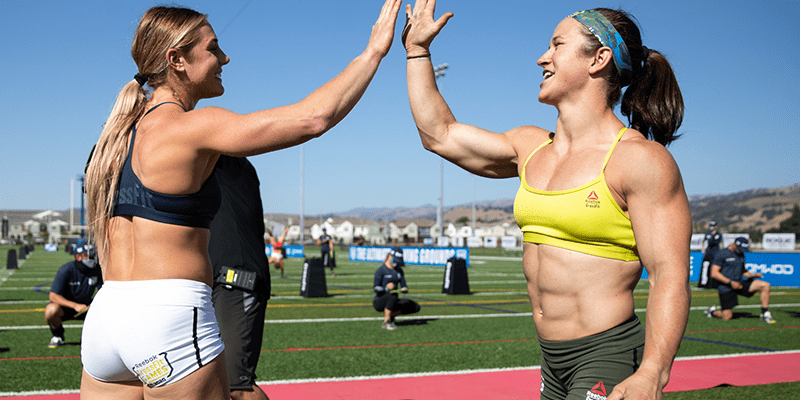
Health Improvements
Better Cardiovascular Health
Increased heart rate and improved circulation from daily exercise contribute to a healthier cardiovascular system.
Enhanced Flexibility and Mobility
Regularly performing these exercises improves joint health and muscle flexibility, reducing the risk of injuries.
Mental Health Benefits
Reduced Stress and Anxiety
Daily physical activity boosts endorphin levels, leading to improved mood and reduced stress and anxiety levels.
Better Sleep
Exercise helps regulate sleep patterns, leading to better quality sleep.
Conclusion
Committing to a regimen of squats, push-ups, and crunches every day for 30 days can lead to substantial physical and mental health benefits. These exercises improve muscle strength and endurance, enhance cardiovascular health, boost metabolic rate, and improve posture and flexibility. However, it’s essential to perform these exercises with proper form and consider incorporating variations and rest to prevent overuse injuries and muscle imbalances. The journey over these 30 days is not just about physical transformation but also about building discipline and improving overall well-being.
Key Takeaways
| Benefit | Description |
|---|---|
| Muscle Strength | Significant increase in muscle strength and endurance, particularly in the legs, upper body, and core. |
| Cardiovascular Health | Improved heart health and circulation from consistent, daily exercise. |
| Metabolic Rate | Enhanced metabolic rate leading to more efficient calorie burning and fat loss. |
| Posture and Flexibility | Better posture and flexibility from strengthened supporting muscles and increased joint mobility. |
| Mental Health | Reduced stress, anxiety, and improved mood through the release of endorphins. |
| Performance Improvements | Increased ability to perform higher repetitions and variations of exercises, indicating improved strength and endurance. |
| Potential Risks | Overuse injuries and muscle imbalances if proper form, variation, and rest are not incorporated. |
References
- Clark, D. R., Lambert, M. I., & Hunter, A. M. (2017). Muscle activation in the loaded free barbell squat: a brief review. Journal of Strength and Conditioning Research, 31(4), 1142-1149.
- Freitas, D. M., et al. (2017). Muscle activity and strength during push-up variations. Journal of Strength and Conditioning Research, 31(12), 3433-3440.
- Willardson, J. M. (2007). Core stability training: applications to sports conditioning programs. Journal of Sports Science & Medicine, 6(1), 40-50.
- American Heart Association. (2018). The benefits of exercise.
- Hunter, G. R., et al. (2015). Resistance training and intra-abdominal adipose tissue in older adults. International Journal of Obesity, 39(2), 292-298.
- Schuch, F. B., et al. (2016). Exercise as a treatment for depression: a meta-analysis adjusting for publication bias. Journal of Psychiatric Research, 77, 42-51.
Was this article helpful?

Fitness
How to become a ‘morning workout’ person – and is it really necessary?

Let’s be honest (and cliched): the best workout is the one you’ll actually do. But if you’re curious about switching to morning sessions for whatever reason – parenting or work duties; making space for your evening social life; you simply can’t be bothered post-work – Women’s Health Collective expert trainer Michelle Griffith-Robinson explains if it’s worth setting those early alarms, and how to make waking up to sweat a bit less of a struggle.
To be clear, you don’t need to become a morning workout person, but there are some benefits.
Benefits of morning workouts
If your blood pressure is above the norm, one study found that 30 minutes of exercise in the morning, followed by frequent breaks from sitting throughout the day, can lower blood pressure for up to eight hours.
Working out in the AM can also help you fall asleep easier, as you’ll kick-start your sleep-wake cycle sooner in the morning, and release melatonin (the hormone that helps you nod off) earlier in the evening. Exercising closer to bedtime will increase heart rate and body temperature, neither of which are conducive to a solid night’s kip. Cortisol levels are higher in the morning, too, and exercise can help regulate them so you feel less stressed throughout the day.
Finally, the endorphins you produce during exercise mean a morning workout can put you in a good mood for the rest of the day. When it comes to getting going, it’s all about discipline. You’ll likely find morning workouts easier during the warmer months, but try to stick with the same routine year-round.
4 tips to become a morning workout person
- Lay out your kit the night before, so that all you have to do is get dressed, and reinforce your routine by scheduling regular sessions so that they become a habit (for example, every Monday and Friday I’m going to train at 7am).
- Making a pact with someone else can also work in your favour, even if you don’t intend on training together –you have them to hold you accountable. A little reward, such as buying a coffee afterwards, or treating yourself to something you’ve been saving up for, can be another great motivator.
- If you’ve tried morning workouts before and struggled, the type of exercise you’re doing could be the problem. Finding a workout you enjoy and look forward to will make getting up so much easier.
- Above all, ensure your chosen time to work out is practical. When can you, realistically, dedicate time to exercise with the least chance of you having to give it a miss? And at what time does exercise make you feel your best? Morning workouts aren’t much use to you if you’re not enjoying them, or they mean you’ll spend the rest of the morning rushed off your feet. Be reasonable with your expectations, and don’t put yourself under too much pressure.
Find a workout that suits you
Cut through the noise and get practical, expert advice, home workouts, easy nutrition and more direct to your inbox. Sign up to the WOMEN’S HEALTH NEWSLETTER

Bridie is Fitness Director at Women’s Health UK. She spends her days sweating over new workouts, fitness launches and the best home gym kit so you have all that you need to get fit done. Her work has been published in Stylist, Glamour, Cosmopolitan and more. She’s also a part-time yoga teacher with a habit of nodding off mid savasana (not when she’s teaching, promise).
Fitness
Should you stretch before exercise? After? Never? Here’s what to know
Panamanian gymnast Hillary Heron stretches as she trains for the Olympics at the No Limits Gymnastics Center in Panama City, Saturday, June 15, 2024, ahead of the Games in Paris.
AP, File
For many people of a certain age, high school gym class began with reaching for their toes. Then, over the years, we were told it was better to stretch after exercise.
It turns out, both those things can be true, but the differing advice has created some confusion.
Stretching can help make you more flexible, improve range of motion in your joints — and feel good. David Behm, who researches human kinetics at Memorial University of Newfoundland in St. John’s, Canada, offers this advice on when to stretch and how to do it safely:
David Behm, author of “The Science and Physiology of Flexibility and Stretching,: Implications and Applications in Sport Performance and Health” stretches.
AP
Warm up first
It’s almost always good to stretch, but it’s better if you warm up first, said Behm, author of “The Science and Physiology of Flexibility and Stretching.” He recommends a light aerobic activity such as jogging, walking or cycling for five or 10 minutes.
Follow that with some static stretching, the traditional way of reaching and holding a position (think back to that gym class). You can then do activity-specific dynamic stretching, in which you warm up the muscles with repetitive movements like leg lifts.
Behm says one minute is “the magic number” for how long to do static stretching per muscle group without fatigue.
The Chicago Cubs mascot playfully stretches with Seiya Suzuki prior to a spring training baseball game against the Los Angeles Angels, Wednesday, March 6, 2024, in Mesa, Ariz.
AP, File
Expand your definition of ‘stretching’
Should you always stretch before exercising? If it’s traditional stretching, not necessarily.
The better question, Behm says, is, “Should people increase their range of motion? Should people have better flexibility? And that is yes, because it helps prevent injuries. It helps with health. But you don’t have to stretch to achieve that.”
Resistance training, for instance, can be an effective form of stretching, he said. Doing a chest press increases range of motion in your deltoids and pecs, whether with barbells, dumbbells or machines, so there is no need to stretch beforehand. Just make sure to start with a small amount of weight to warm up and then add more to train.
“You probably don’t have to do extra stretching unless you’re a gymnast, a figure skater, or even a golfer who needs a great range of motion through that swing,” Behm said.
Nor do you need to stretch first if you’re going for a leisurely run. Simply start with a slow jog to warm up and then increase the pace.
Don’t do it if it hurts
After exercise, “light stretching is OK, as long as you don’t reach a point where you’re feeling pain,” Behm said. Since your muscles will be warm by that point, overdoing it makes you more likely to injure yourself.
Foam rollers can help with muscle recovery and have been shown to increases range of motion as well as stretching.
Do some static stretching before sports
If you’re playing a sport, Behm said, static stretching beforehand helps reduce muscle and tendon injury.
“If you’re going to do an explosive movement, change of direction, agility, sprint, any of these explosive activities that involve your muscles and tendons,” he said, “you’re going to be stronger if you do static stretching.”
People can especially get in trouble when they go back to a sport they used to play, whether it’s tennis, surfing or any sort of team activity.
Also, stretch both sides equally. Lacking flexibility on one side also can lead to injury.
Sounds simple. Why all the confusion?
Different studies over the years have either encouraged or discouraged stretching before exercise. Behm says that partly because some studies didn’t reflect real-life conditions, or were designed with elite athletes in mind, not regular people.
“If you’re Usain Bolt, it makes a difference,” said Behm. Not so much for the rest of us.
Fitness
If You Can Do These 10 Balance Exercises, You’re in Good Shape
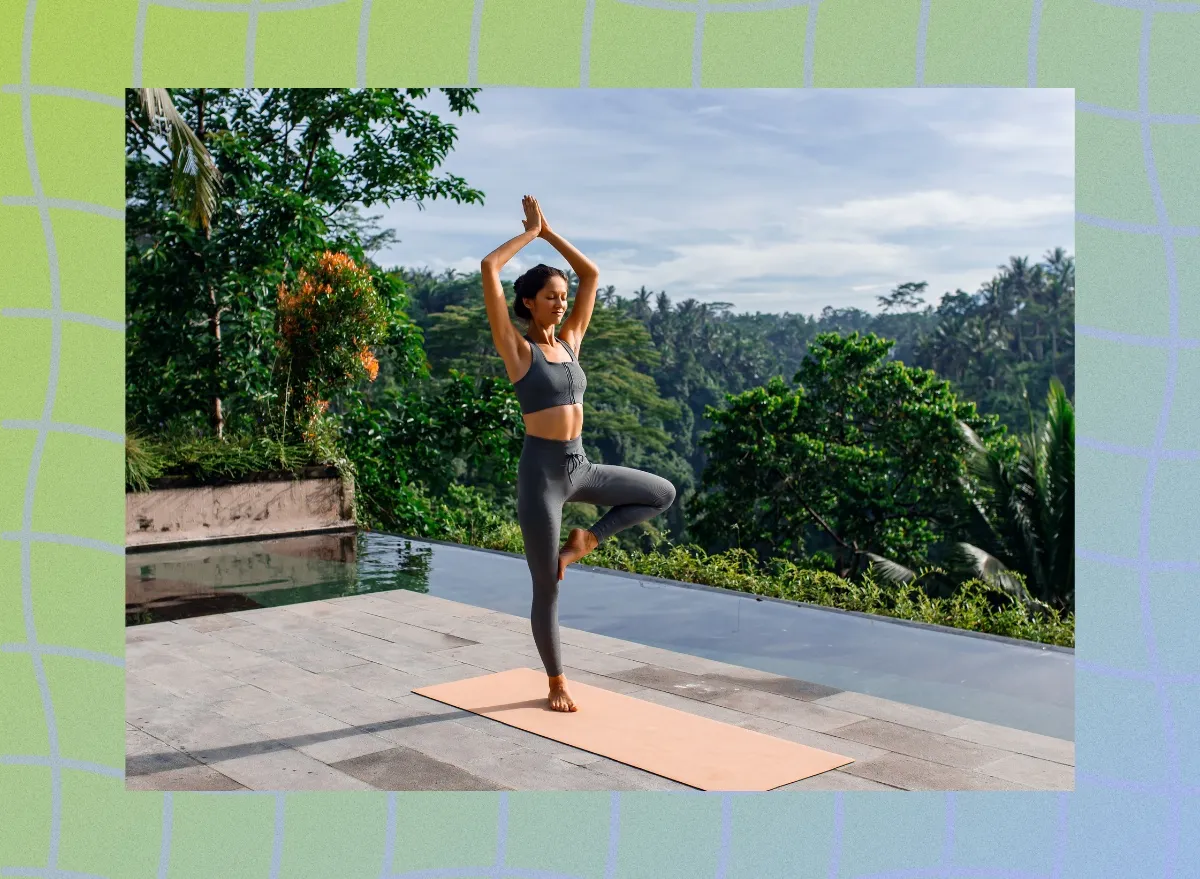
Balance isn’t just for tightrope walkers or yogis. It’s a crucial component of overall fitness that enhances your ability to perform everyday tasks, from walking and climbing stairs to playing sports and lifting weights. Good balance can help prevent injuries, improve coordination, and boost physical performance. It’s an often-overlooked aspect of fitness that deserves more attention in your training regimen. That’s why we’ve rounded up some of the best balance exercises that reveal whether or not you’re in good shape.
Balance naturally declines as you age, increasing the risk of falls and injuries. Incorporating balance exercises into your routine can counteract this decline, enhancing your stability and overall quality of life. Whether you’re an athlete aiming to elevate your performance or want to move more confidently and securely through daily activities, working on your balance offers substantial benefits.
Ready to test your performance? These 10 balance exercises can help you assess and improve your stability, ensuring you’re in good, if not even great, shape. Each exercise challenges your balance differently, delivering a well-rounded approach to this essential fitness component.
If you can master these balance exercises, you’ll be well on your way to achieving better balance and overall fitness!
Single-leg Stand
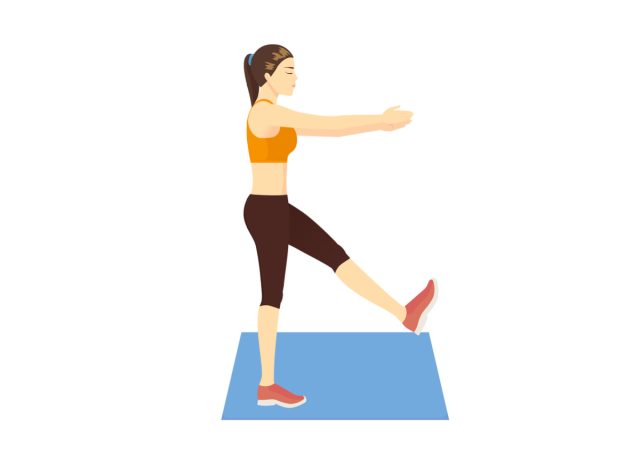
The single-leg stand is a fundamental balance exercise that tests your static balance and lower-body stability. It’s beneficial for identifying imbalances between your left and right sides.
This exercise engages the stabilizing muscles in your ankles, knees, and hips, promoting joint health and reducing the risk of injuries. Additionally, it enhances proprioception, which is your body’s ability to sense its position in space, which is crucial for maintaining balance and coordination in everyday activities and athletic pursuits.
Stand tall with your feet together. Lift your right foot off the ground and bend your knee to form a 90-degree angle. Hold this position for 30 seconds to a minute without letting your hips tilt or your standing knee wobble. Switch to your left foot and repeat. To increase the difficulty, try closing your eyes or standing on an unstable surface like a foam pad.
Tree Pose
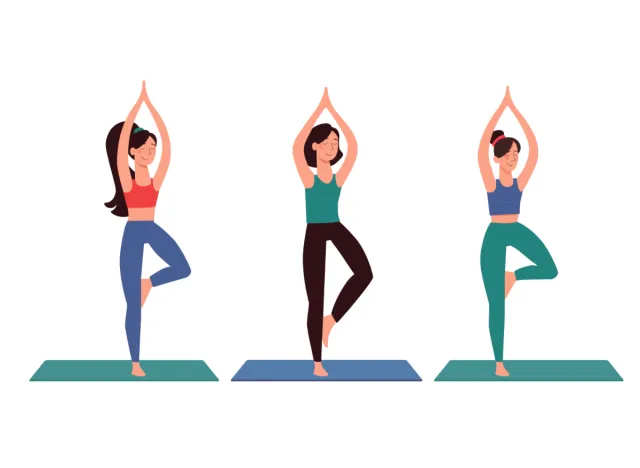

A staple in yoga, the tree pose improves static balance, focus, and proprioception and strengthens the muscles around your ankles and knees. By requiring you to balance on one leg while maintaining a specific posture, the tree pose enhances your mental concentration and mindfulness.
It encourages proper alignment and posture, which can translate to better overall body mechanics. Additionally, the tree pose stretches the groin, inner thighs, chest, and shoulders, contributing to flexibility and muscle balance.
Stand with your feet together and your arms at your sides. Shift your weight onto your left foot and place the sole of your right foot against your inner left thigh or calf (avoid placing it directly on the knee). Bring your hands together in front of your chest in a prayer position. Hold for 30 seconds to a minute, then switch sides. For an added challenge, extend your arms overhead or close your eyes.
Single-leg Romanian Deadlift (RDL)
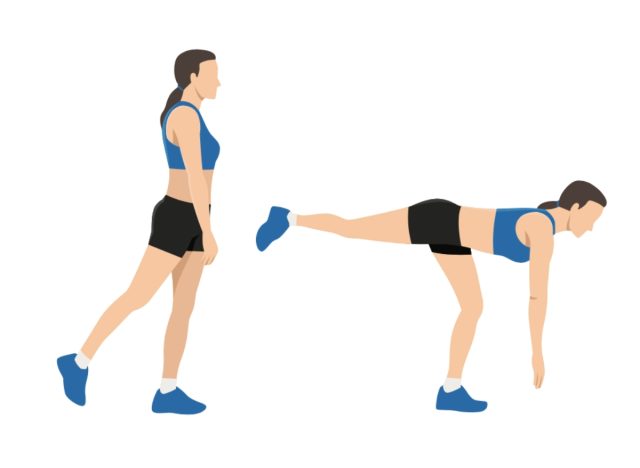

The single-leg RDL targets your hamstrings, glutes, and core while challenging your dynamic balance. It’s excellent for improving stability and strength in the posterior chain. This exercise enhances hip mobility and can help correct muscular imbalances that often lead to injuries.
By engaging your core muscles throughout the movement, the single-leg RDL promotes better posture and alignment, reducing the strain on your lower back. This exercise is particularly beneficial for athletes, as it mimics the movements required in many sports that involve running, jumping, and changing directions.
Stand on your right leg with a slight bend in the knee. Hinge at your hips, extending your left leg straight behind you while lowering your torso toward the ground. Keep your back flat and your hips squared to the floor. Reach your hands toward the ground or hold a weight for added resistance. Return to the starting position and repeat for eight to 12 reps before switching legs.
Split Squat
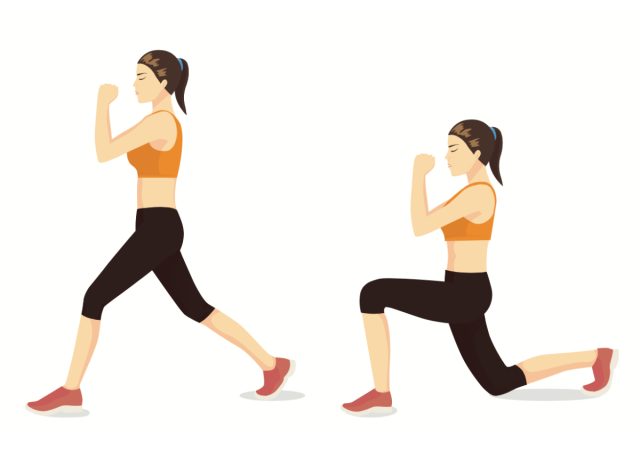

The split squat enhances lower-body strength and balance, particularly in the quadriceps and glutes. It also helps improve hip mobility and stability. This exercise isolates each leg, allowing you to focus on developing unilateral strength, which can help correct muscular imbalances and improve overall leg strength.
By requiring you to stabilize your body in a split stance, the split squat engages your core muscles and promotes better balance and coordination. It’s a versatile exercise you can modify with weights or varying stances to target different muscle groups and intensities.
Start in a staggered stance with your right foot forward and left foot back, about two feet apart. Lower your body until your right thigh is parallel to the ground and your left knee nearly touches the floor. Keep your torso upright and your front knee aligned over your ankle. Push through your right heel to return to the starting position. Perform eight to 12 reps before switching legs.
Single-leg Squat to Box
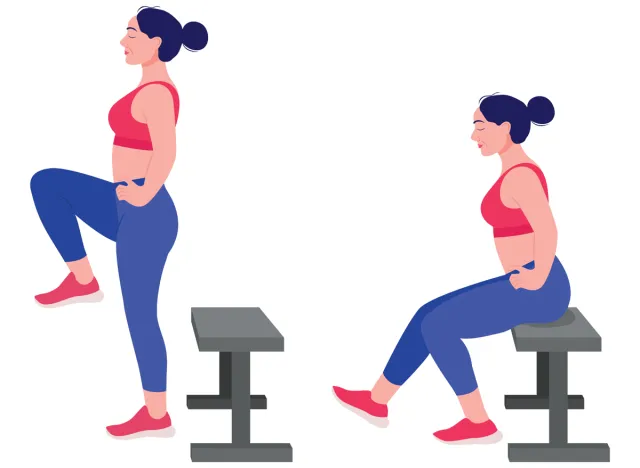

This exercise improves single-leg strength, balance, and coordination. It also helps identify and correct imbalances between your legs. You engage your quadriceps, hamstrings, glutes, and calves by performing a controlled squat on one leg, enhancing lower body strength and stability.
The single-leg squat to box also challenges your core muscles to maintain proper alignment and balance, reducing the risk of lower back strain. This exercise can improve your performance in activities that require unilateral strength and stability, such as running, jumping, and changing directions.
Stand on your right leg in front of a box or bench. Slowly lower yourself into a squat, lightly tapping your glutes on the box. Keep your left leg extended in front of you and your torso upright. Push through your right heel to return to the starting position. Perform six to 10 reps before switching legs. Start with a higher box and gradually decrease the height as you get stronger.
Single-arm Plank
The single-arm plank challenges your core stability and upper-body strength and tests your ability to maintain balance with asymmetrical loading. Lifting one arm off the ground forces your core muscles, particularly the obliques and transverse abdominis, to work harder to stabilize your body.
This exercise also engages your shoulders, chest, and back muscles, promoting upper-body strength and endurance. The single-arm plank improves your coordination and balance, making it an excellent addition to any functional training routine.
Begin in a standard plank position with your hands directly under your shoulders and your body in a straight line. Lift your right hand off the ground and extend it straight before you or keep it by your side. Hold for 10 to 20 seconds, keeping your hips level and your core engaged. Switch to your left hand and repeat. To increase the difficulty, try lifting the opposite leg simultaneously.
Suitcase Carry
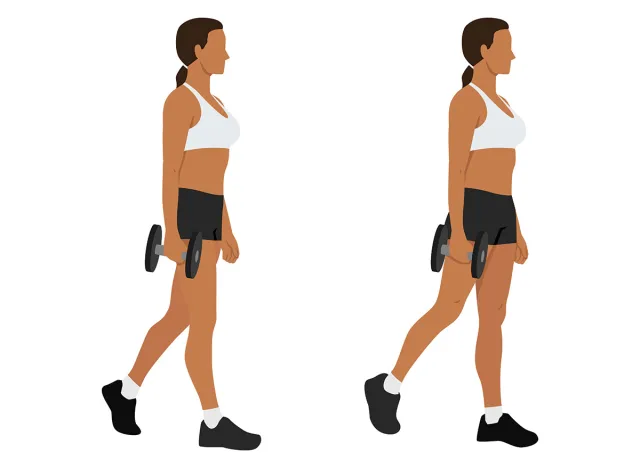

The suitcase carry tests your dynamic balance, grip strength, and core stability. It mimics carrying a heavy object in one hand, which requires significant stabilization. This exercise engages your obliques, shoulders, and grip muscles, promoting overall functional strength.
The suitcase carry also improves your posture by encouraging you to maintain an upright position while carrying an asymmetrical load. It’s a practical exercise that enhances your ability to perform everyday tasks, such as carrying groceries or lifting objects, with better balance and reduced risk of injury.
Hold a heavy dumbbell or kettlebell in your right hand at your side. Stand tall with your shoulders back and your core engaged. Walk forward for 30 to 50 feet, maintaining an upright posture and avoiding leaning or twisting. Switch hands and repeat. Focus on keeping your steps controlled and even.
Heel-to-Toe Walk
This exercise enhances dynamic balance and coordination, making it particularly useful for improving gait and stability. The heel-to-toe walk engages the muscles in your lower legs and feet, promoting strength and endurance in these areas.
This exercise challenges your proprioception and spatial awareness by requiring you to place one foot directly in front of the other, helping you maintain better balance and coordination. The heel-to-toe walk is an excellent exercise for older adults or anyone looking to improve their walking mechanics and reduce the risk of falls.
Stand with your feet together. Step forward with your right foot, placing your heel directly before your left toe. Continue walking straight, placing each heel directly before the opposite toe. Keep your eyes forward and your arms at your sides or extended for balance. Perform for 20 to 30 steps.
Lateral Shuffle
The lateral shuffle improves lateral movement, agility, and dynamic balance. It’s excellent for athletes who need to move quickly in different directions. This exercise engages your hip abductors, adductors, and quadriceps, promoting strength and stability in these muscle groups.
The lateral shuffle also enhances cardiovascular fitness and coordination, making it an excellent addition to high-intensity interval training (HIIT). By improving your ability to move laterally, this exercise can enhance your performance in sports and activities that require quick direction changes, such as basketball, tennis, and soccer.
Stand with your feet shoulder-width apart and your knees slightly bent. Shuffle to your right by pushing off your left foot and stepping your right foot to the side. Follow with your left foot, keeping your feet apart and your movements quick and controlled.
Shuffle for 10 to 20 feet, then switch directions. Perform for 30 to 60 seconds.
Three-way Toe Taps
This exercise tests your balance and proprioception in multiple directions. It strengthens your ankles, calves, and core. Tapping your toes in different directions challenges your ability to maintain balance while shifting your weight, promoting better coordination and stability.
The three-way toe taps engage your hip flexors, glutes, and lower leg muscles, enhancing overall lower-body strength and endurance. This balance exercise is particularly beneficial for improving your ability to perform multi-directional movements, such as those required in sports and daily activities.
Stand on your right leg with a slight bend in the knee. Tap your left toes forward, to the side, and then behind you, returning to the starting position after each tap. Keep your torso upright and your movements controlled. Perform eight to 12 taps in each direction before switching legs.
-

 Mississippi4 days ago
Mississippi4 days agoMSU, Mississippi Academy of Sciences host summer symposium, USDA’s Tucker honored with Presidential Award
-

 World1 week ago
World1 week agoTyphoon Gaemi barrels towards China’s Fujian after sinking ship off Taiwan
-

 News1 week ago
News1 week agoVideo: Biden Says It’s Time to ‘Pass the Torch’ to a New Generation
-

 Politics6 days ago
Politics6 days agoRepublicans say Schumer must act on voter proof of citizenship bill if Democrat 'really cares about democracy'
-

 News1 week ago
News1 week agoVideo: Kamala Harris May Bring Out Trump’s Harshest Instincts
-

 News1 week ago
News1 week agoWho Can Achieve the American Dream? Race Matters Less Than It Used To.
-
World6 days ago
More right wing with fewer women – a new Parliament compendium
-

 Politics1 week ago
Politics1 week agoHouse unanimously votes to create Trump assassination attempt commission














